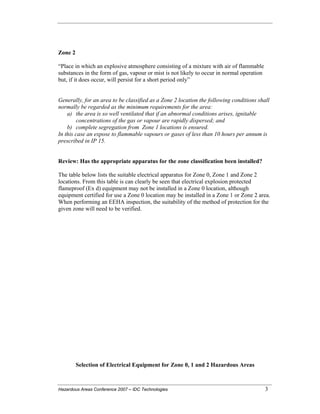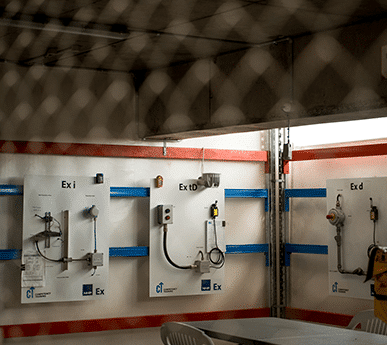Roar Solutions - Truths
Roar Solutions - Truths
Blog Article
Unknown Facts About Roar Solutions
Table of ContentsAll about Roar SolutionsAll about Roar SolutionsThe 6-Minute Rule for Roar Solutions
In order to protect setups from a possible explosion a technique of evaluating and categorizing a possibly unsafe area is needed. The objective of this is to ensure the proper option and installation of equipment to ultimately protect against a surge and to guarantee safety and security of life.
(https://roarsolutions6.godaddysites.com/f/roar-training-solutions-and-eeha-courses)
No tools must be mounted where the surface area temperature of the devices is above the ignition temperature of the given risk. Below are some common dust harmful and their minimum ignition temperature level. Coal Dirt 380C 225C Polythene 420C (melts) Methyl Cellulose 420C 320C Starch 460C 435C Flour 490C 340C Sugar 490C 460C Grain Dirt 510C 300C Phenolic Material 530C > 450C Aluminium 590C > 450C PVC 700C > 450C Residue 810C 570C The chance of the danger existing in a focus high sufficient to create an ignition will certainly differ from place to area.
In order to classify this threat a setup is separated right into areas of threat depending upon the amount of time the harmful is existing. These areas are described as Areas. For gases and vapours and dirts and fibres there are three areas. Area 0 Area 20 A dangerous environment is extremely likely to be existing and may be existing for extended periods of time (> 1000 hours annually) or also constantly Zone 1 Area 21 A dangerous atmosphere is possible but not likely to be present for lengthy periods of time (> 10 450 C [842 F] A classification of T6 indicates the minimal ignition temperature is > 85 C [185 F] Hazardous location electrical tools perhaps made for usage in higher ambient temperatures. This would showed on the ranking plate e.g. EExe II C T3 Ta + 60C( This implies at 60C ambient T3 will certainly not be exceeded) T1 T1, T2, T3, T4, T5, T6 T2 T2, T3, T4, T5, T6 T3 T3, T4, T5, T6 T4 T4, T5, T6 T5 T5, T6 T6 T6 A T Course rating of T1 implies the maximum surface area temperature created by the instrument at 40 C is 450 C. Presuming the linked T Course and Temperature level ranking for the tools are appropriate for the location, you can constantly use a tool with a more rigid Division ranking than required for the location. There isn't a clear solution to this concern sadly. It truly does depend upon the type of tools and what repair services require to be accomplished. Tools with particular test treatments that can't be done in the field in order to achieve/maintain third party score. Must return to the manufacturing facility if it is before the equipment's solution. Area Repair Work By Authorised Employee: Difficult screening might not be called for nonetheless details procedures may need to be adhered to in order for the devices to preserve its 3rd event rating. Authorised personnel need to be used to carry out the work correctly Repair need to be a like for like substitute. New element must be thought about as a straight replacement needing no special testing of the tools after the repair service is full. Each item of devices with a dangerous score must be examined independently. These are described at a high level below, but also for even more comprehensive information, please refer directly to the standards.
Not known Incorrect Statements About Roar Solutions
The devices register is a thorough data source of tools records that consists of a minimum collection of fields to determine each item's place, technical parameters, Ex lover classification, age, and environmental information. This details is vital for tracking and managing the equipment effectively within unsafe areas. On the other hand, for regular or RBI tasting evaluations, the grade will be a combination of Thorough and Close assessments. The ratio of Thorough to Shut assessments will certainly be identified by the Tools Danger, which is assessed based upon ignition danger (the probability of a resource of ignition versus the probability of a combustible atmosphere )and the dangerous area classification
( Area 0, 1, or 2). This variation will certainly also affect the resourcing needs for work prep work. Once Great deals are specified, you can create sampling plans based upon the sample dimension of each Whole lot, which refers to the number of random equipment items to be checked. To identify the needed example size, two facets need to be examined: the dimension of the Lot and the classification of examination, which shows the level of initiative that should be applied( reduced, normal, or enhanced )to the evaluation of the Great deal. By incorporating the group of examination with the Great deal dimension, you can then develop the ideal rejection standards for an example, suggesting the permitted variety of faulty products found within that sample. For even more information on this YOURURL.com process, please describe the Energy Institute Guidelines. The IEC 60079 common advises that the maximum interval in between assessments need to not go beyond 3 years. EEHA inspections will also be carried out beyond RBI projects as component of scheduled upkeep and devices overhauls or repairs. These evaluations can be credited toward the RBI sample dimensions within the affected Great deals. EEHA evaluations are conducted to identify faults in electric equipment. A heavy racking up system is essential, as a solitary item of tools might have several faults, each with differing degrees of ignition risk. If the consolidated score of both examinations is less than twice the fault score, the Lot is deemed acceptable. If the Whole lot is still taken into consideration unacceptable, it has to undergo a complete evaluation or justification, which may set off more stringent examination methods. Accepted Great deal: The sources of any mistakes are recognized. If an usual failure setting is discovered, added tools might require maintenance. Mistakes are identified by extent( Security, Honesty, Housekeeping ), making sure that immediate problems are analyzed and resolved quickly to reduce any type of influence on safety or operations. The EEHA database should track and tape-record the lifecycle of faults together with the restorative activities taken. Executing a robust Risk-Based Examination( RBI )technique is critical for making sure compliance and safety in handling Electrical Devices in Hazardous Areas( EEHA) (electrical refresher course). Automated Mistake Rating and Lifecycle Administration: Easily manage mistakes and track their lifecycle to enhance examination precision. The introduction of this assistance for risk-based inspection additionally strengthens Inspectivity's position as a best-in-class remedy for regulatory compliance, along with for any type of asset-centric inspection usage situation. If you are interested in discovering more, we invite you to request a demonstration and discover exactly how our option can change your EEHA administration procedures.
The 3-Minute Rule for Roar Solutions

In terms of eruptive threat, an unsafe location is an atmosphere in which an eruptive atmosphere exists (or might be anticipated to be present) in amounts that require special safety measures for the building and construction, setup and usage of tools. Roar Training Solutions. In this article we check out the obstacles dealt with in the workplace, the threat control steps, and the needed proficiencies to function safely
It issues of modern life that we produce, save or deal with a variety of gases or fluids that are deemed flammable, and a range of dirts that are regarded flammable. These substances can, in specific problems, develop eruptive ambiences and these can have major and heartbreaking effects. Many of us know with the fire triangular get rid of any kind of one of the three aspects and the fire can not take place, yet what does this mean in the context of hazardous locations? When damaging this down right into its most basic terms it is basically: a mix of a specific quantity of launch or leak of a certain compound or product, mixing with ambient oxygen, and the existence of a resource of ignition.
In most instances, we can do little concerning the degrees of oxygen in the air, however we can have considerable impact on sources of ignition, as an example electrical equipment. Unsafe areas are documented on the unsafe location classification illustration and are identified on-site by the triangular "EX-SPOUSE" sign. Below, among various other vital details, areas are divided right into three kinds depending upon the hazard, the likelihood and period that an eruptive environment will exist; Zone 0 or 20 is regarded one of the most dangerous and Zone 2 or 22 is regarded the least.
Report this page